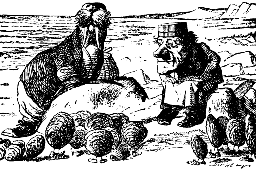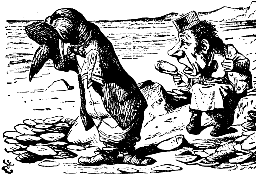
Happy Birthday
Lewis Carroll!! Jan. 27 would have been his 181st birthday! Why are we toasting the author of
Alice's Adventures in Wonderland on Oyster Stew?
Mr. Carroll is the author of perhaps the most famous oyster story ever. In his more famous book
Through the Looking Glass, Tweedledee and Tweedledum recite a poem to Alice entitled
The Walrus and the Carpenter.
The poem is about a walrus and carpenter who take a walk along the beach one night when they come upon a bed of oysters. They invite four of the oysters to join them (having no feet didn't seem to be a problem in Wonderland). Despite the eldest oyster's warnings, the four oysters went with the walrus and carpenter. The walrus and the carpenter ate the oysters.
Oops. Should have listened to big brother.
I've included the poem in its entirety below. It's in the public domain now, so I'm not ripping anyone off, just in case you were wondering.
 |
Walrus & Carpenter Oyster Bar
Faneuil Hall, Boston |
And now you know, if you didn't already, why oyster bars from Seattle to Boston are named after the walrus and the carpenter. Our two favorites:
The Walrus and the Carpenter
4743 Ballard Ave NW
Seattle, WA 98107
Chef Renee Erickson is letting the oyster sing in the newly restored Kolstrand building. Named #3 Best New Restaurants in America by Bon Appetit magazine in 2011.
Walrus & the Carpenter
200 Faneuil Hall Market Place
Boston, MA 02109
Get past the fact that it's in one of America's favorite food courts, and you'll see that in the right hands, oysters can be served anywhere, anytime.
The Walrus and The Carpenter
Lewis Carroll
(from Through the Looking-Glass and What Alice Found There, 1872)
The sun was shining on the sea,
Shining with all his might:
He did his very best to make
The billows smooth and bright--
And this was odd, because it was
The middle of the night.
The moon was shining sulkily,
Because she thought the sun
Had got no business to be there
After the day was done--
"It's very rude of him," she said,
"To come and spoil the fun!"

The sea was wet as wet could be,
The sands were dry as dry.
You could not see a cloud, because
No cloud was in the sky:
No birds were flying overhead--
There were no birds to fly.
The Walrus and the Carpenter
Were walking close at hand;
They wept like anything to see
Such quantities of sand:
"If this were only cleared away,"
They said, "it would be grand!"
"If seven maids with seven mops
Swept it for half a year.
Do you suppose," the Walrus said,
"That they could get it clear?"
"I doubt it," said the Carpenter,
And shed a bitter tear.
"O Oysters, come and walk with us!"
The Walrus did beseech.
"A pleasant walk, a pleasant talk,
Along the briny beach:
We cannot do with more than four,
To give a hand to each."
The eldest Oyster looked at him,
But never a word he said:
The eldest Oyster winked his eye,
And shook his heavy head--
Meaning to say he did not choose
To leave the oyster-bed.
But four young Oysters hurried up,
All eager for the treat:
Their coats were brushed, their faces washed,
Their shoes were clean and neat--
And this was odd, because, you know,
They hadn't any feet.
Four other Oysters followed them,
And yet another four;
And thick and fast they came at last,
And more, and more, and more--
All hopping through the frothy waves,
And scrambling to the shore.

The Walrus and the Carpenter
Walked on a mile or so,
And then they rested on a rock
Conveniently low:
And all the little Oysters stood
And waited in a row.
"The time has come," the Walrus said,
"To talk of many things:
Of shoes--and ships--and sealing-wax--
Of cabbages--and kings--
And why the sea is boiling hot--
And whether pigs have wings."
"But wait a bit," the Oysters cried,
"Before we have our chat;
For some of us are out of breath,
And all of us are fat!"
"No hurry!" said the Carpenter.
They thanked him much for that.
"A loaf of bread," the Walrus said,
"Is what we chiefly need:
Pepper and vinegar besides
Are very good indeed--
Now if you're ready, Oysters dear,
We can begin to feed."
"But not on us!" the Oysters cried,
Turning a little blue.
"After such kindness, that would be
A dismal thing to do!"
"The night is fine," the Walrus said.
"Do you admire the view?

"It was so kind of you to come!
And you are very nice!"
The Carpenter said nothing but
"Cut us another slice:
I wish you were not quite so deaf--
I've had to ask you twice!"
"It seems a shame," the Walrus said,
"To play them such a trick,
After we've brought them out so far,
And made them trot so quick!"
The Carpenter said nothing but
"The butter's spread too thick!"
"I weep for you," the Walrus said:
"I deeply sympathize."
With sobs and tears he sorted out
Those of the largest size,
Holding his pocket-handkerchief
Before his streaming eyes.
"O Oysters," said the Carpenter,
"You've had a pleasant run!
Shall we be trotting home again?'
But answer came there none--
And this was scarcely odd, because
They'd eaten every one.




























